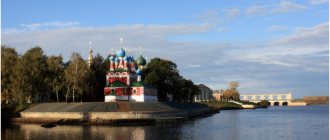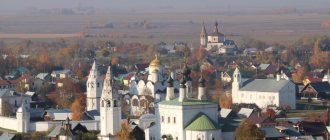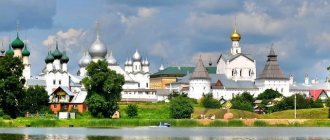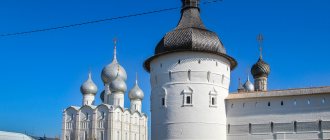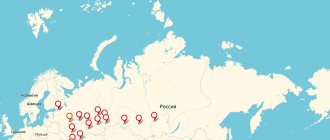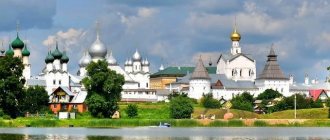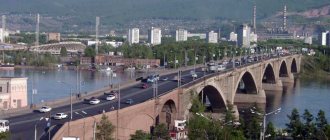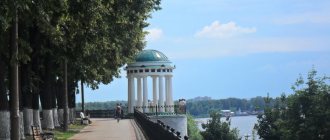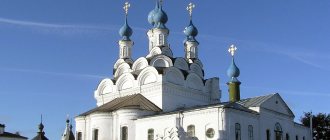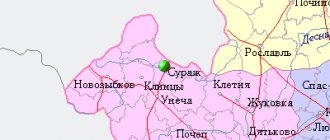The most ancient and beautiful cities in Russia are provincial, quiet, and not very large. But, probably, this is what is needed in order to preserve the dignity and severity of ancient architectural monuments, not to lose the leisurely charm of the original Russian way of life, not to lose the charm of the epic spirit that is simply in the air in such places. The city of Rostov the Great (Yaroslavl region) is not in vain included in the Golden Ring of Russia. It is small - only 30 thousand inhabitants, as Wikipedia helpfully reports. It will take no more than two hours to walk from one end of the city to the other. If you wish, you can explore the main attractions of the city in one day, although this will be difficult - it’s easier then to just look through a guidebook with photos and descriptions and stay at home. But if you still decide to arrange an unusual weekend with a trip to the glorious past of Russia, it is better to take your time and fully enjoy the beauty of this area and its unique monuments.
Lake Nero
It’s worth starting with the lake, because it’s everywhere here, and it appeared much earlier than the town itself. Scientists believe that the lake is at least 500 thousand years old. But this is not the only thing that makes the reservoir unique. Firstly, people cannot swim in it because of the muddy bottom and muddy water - in some places the thickness of the silt layer reaches 20 meters. Secondly, as many as 17 rivers flow into it, but only one flows out. And thirdly, perhaps, under its dark waters, in the muddy layers, the legendary city of Kitezh and the golden treasures of ancient monks are buried. So far no one has found them, but the excitement has not subsided for decades.
The lake itself is small and shallow, its area is just over 50 square meters. km, and the depth only in some places reaches three meters. This place is not for swimming and not for full-fledged navigation, except for fishing and trips on a light boat. By the way, catching a pike here, and not the usual bream or carp, means earning the respect of local old-timers and experienced fishermen, since the pike in Lake Nero are very cunning. Remember this when you are served the rich Rostov soup made from it, hand-made dumplings with minced pike, and the head, a royal delicacy, on a separate dish, with a garnish of salted boletus mushrooms.
Spaso-Yakovlevsky Monastery
Spaso-Yakovlevsky Monastery was founded by the Rostov Bishop Jacob in 1389. His flock expelled him from the city because, according to popular opinion, the verdict was incorrect - Jacob sent the criminal to a monastery instead of executing her.
The exiled bishop himself built a temple on the shores of Lake Nero, and he himself consecrated it in honor of the Conception of the Blessed Virgin Mary. Gradually, his supporters began to settle nearby, Jacob was canonized, and the community began to grow, forming a monastery.
A surge of interest in the Spaso-Yakovlevsky Monastery began after 1757, when Metropolitan Dmitry of Rostov was canonized. He died in 1709 and was buried in the Conception Cathedral. When the tomb was repaired in 1752, it turned out that his relics and clothes were not touched by decay. There was talk about miraculous healings at the relics (288 of them were recorded in just 11 years).
The monastery grew rich and expanded. A stone fence, Demetrius Cathedral, the Church of St. James, and other temples and buildings were erected. All Russian emperors came on pilgrimage to the Spaso-Yakovlevsky Monastery. The monastery housed a rich collection of historical documents, manuscripts and books.
1917 came, and everything gradually fell apart. The monks were expelled, the collections were stolen from towns and villages. Fortunately, the buildings were not blown up - they were suitable for both housing and economic needs. Now the monastery has been completely restored, the monks proudly talk about their own greenhouses, mechanical workshops and car park.
The territory of the Spaso-Yakovlevsky Monastery is quite clearly divided into “front” and “household” parts. The three active temples are lined up like soldiers, facing east, while the auxiliary buildings are concentrated in the western part of the territory.
The first stone building of the monastery was the Conception Cathedral, built in 1686 in a patterned style on the site of a wooden church of the same name. Dimitrievsky Cathedral was consecrated in 1801; its building was built in the style of classicism. Finally, in 1836, the Yakovlevskaya Church was built close to the Conception Cathedral. The churches are adjacent to each other, they even have a common entrance portal, but it is easy to distinguish them: the blue domes with a gold central one belong to the Conception Cathedral.
The best way to view the monastery is from the observation deck in the southwestern tower or even from the water during a boat ride (500 rubles). A pedestrian visit to the Spaso-Yakovlevsky Monastery is formally free, but you need to make a donation.
Rostov Kremlin
Everyone, even the smallest Rostovite, is rightfully proud of this monument of history, culture, architecture and religion. Many centuries ago (approximately 1670), Metropolitan Jonah Sysoev conceived a project of unprecedented scope at that time - to create a real biblical Garden of Eden on earth. And in it - a spacious residence for himself. The Garden of Eden actually turned out to be an apple tree, but fruitful and beautiful, with a small pond in the middle. Several temples with all the accompanying buildings grew up around this pond.
The Kremlin itself has never had any defense function, so calling it that is not entirely correct. After the transfer of the metropolis to Yaroslavl, it completely lost its significance; it was almost demolished along with the neglected churches around it, but the local merchants intervened, bought the entire complex and restored it at their own expense. Today, the restored and restored churches form a single architectural ensemble and are monuments of federal significance. It was here that the cult comedy of the Soviet period “Ivan Vasilyevich Changes His Profession” was filmed, because many of the buildings, stairs and passages connecting them are familiar to tourists. But first things first.
Belfry
It was built in 1687 next to the Assumption Cathedral; three of the largest bells in Russia are located in three spans of the structure. Their chime fascinates everyone, the acoustic effect enhances the proximity of Lake Nero. The main pride of the belfry is stored in a special extension - the huge bell “Sysoy” weighing 32 tons, cast in the second half of the 17th century at the Moscow Cannon Yard.
Assumption Cathedral
It seems that this temple has always been in Rostov the Great. When exactly and who built it is still unknown, but in documents from 1161 the cathedral was already described as white stone. A hundred years later, it was completely destroyed by fire; the new building, which had been erected for 20 years, also quickly crumbled. The last time the cathedral was rebuilt was in the 14th century, at the same time a diocese settled under its arches; the church residence remained here until the end of the 18th century. The majestic, beautiful building in the style of Vladimir-Suzdal architecture with typical helmet-shaped domes was carefully restored several times, managed to withstand numerous wars, and even survived the period of Bolshevik rule without losses, although the cathedral was temporarily closed.
Red Chamber
Located in the Kremlin itself, it is a two-story state mansion of stunning, simply fabulous architecture.
The main chambers are led by a double-hipped porch with the richest decoration: there are carved supports, arches with intricate patterns, and gilded coats of arms. The chambers themselves are richly decorated with figured platbands. Visually, the red chamber is very reminiscent of the mansions of the Moscow Kremlin. This is not all that is worth seeing in the Rostov Kremlin, but it is enough for one day. The power and grandeur of this complex is slightly overwhelming; you need to receive impressions in doses. Please note that in the evening almost all areas of the Kremlin are closed. You can simply walk around the area for a fee, but it is better to come here during the day with a guide.
Museums
The main museum of the city is the Rostov Kremlin. There are dozens of displays and exhibitions here, both permanent and changing. In the Museum's Picture Gallery you can see paintings by famous artists: Shishkin, Aivazovsky, Malevich. The Museum of Enamel has beautiful items painted on enamel; this collection of Rostov enamel is the largest in the country and includes more than two and a half thousand items. The exhibition “Ancient Russian Art” will tell you about ancient icons and many other ancient things - sewing, precious utensils, carved and cast items - all of this is located in eight halls.
The Frog Princess Museum is located next to the Kremlin, in an old mansion. Here you can see more than two thousand of these fabulous animals and other magical creatures, and also take part in competitions and taste dishes from the Russian oven.
“Lukovaya Sloboda” is an unusual complex, on the ground floor of which there is a cafe, on the menu - all dishes exclusively with onions. On the second floor there is an exhibition telling about the cultivation of onions and Rostov agriculture. Here you can also make your own amulet, of course, from onions, and buy onion jam.
Another museum dedicated to Rostov enamel (this craft is also called “fire writing”) operates at the factory of the same name. Another craft museum is the Horse Gallery and the House of Crafts, dedicated to modern painting and folk crafts.
General information for tourists
The city of Rostov the Great is located on the Northern Highway, so getting here by train from anywhere in the country will not be a problem.
Another thing is that if you travel from St. Petersburg, you will have to change trains. The same applies to the most accessible method of transportation from Moscow – electric trains. You will have to make a transfer in Aleksandrov, spending a total of at least five hours on the road. It is better to go to the Yaroslavl station and buy a ticket for a passenger train. It costs several times more, but you will get directly to your destination in a comfortable carriage in a maximum of four hours. Another option for getting to Rostov is buses. Several flights leave from Moscow per day in different directions, going through Rostov; buying a ticket is not at all a problem right before departure. If you go by private car, then excluding traffic jams, the journey by car will take no more than 3 hours.
In any case, you will not have time to leave on the same day - the road is not close, and there are many attractions. Experienced tourists recommend thinking about spending the night before leaving. Hotels in Rostov offer the most ordinary rooms at not the cheapest prices, and even you can’t always get them - in the high season, with an influx of tourists, hotels and guest houses are overcrowded. But don’t despair - there is always the opportunity to get an overnight stay at one of the tourist bases in the vicinity of Rostov. At the same time, you can organize a fishing trip or a picnic in nature, completely isolated from civilization. And if you wish, you can stay in the chambers of a real noble estate with a beautiful view of the lake from the windows.
Rostov the Great - the capital of onions
What is Rostov the Great famous for? - with a bow! It was once the onion capital of Russia. The subject of trade between Russia and other nations included vegetables. Onions were successfully bred near Rostov the Great, Suzdal and Murom. According to scientists, onion culture came here from the Danube more than a thousand years ago. And already in the 9th century, the Rostov land became the center of gardening. And soon the Rostov onion gained fame far beyond the borders of this region. Now the fact that Rostov is the capital of onions will be reminded by the merchants sitting along the roads leading to Rostov, selling braids and bunches of onions. Large glossy golden bulbs, slightly flattened in the manner of church domes, sparkle with their smooth sides in the sun.
Back in the 18th century, Archbishop Samuel wrote: “...local residents get rid of all their diseases with onions and garlic, they never require any medicine and cannot stand the doctor at all. To my utter surprise, those born here live for ninety years or more, but they completely stink of onions and garlic.”
An ancient Rostov dish is “scalded” onions. Onions cut into half rings were boiled with boiling water twice and cooled. Seasoned with linseed or hemp oil and eaten with black bread.
The Rostov onion variety is distinguished by the fact that the size and weight of the bulbs are large, the taste is sharp, sweet, and juicy. In winter, during storage, the Rostov variety does not germinate. Such onions grow here thanks to sapropel (silt) from nearby Lake Nero, which local residents use to fertilize their gardens.
Rostov Veliky, Lake Nero
Rostov the Great, Rostov Kremlin
Metropolitan Garden
In the 17th century, the Metropolitan Garden was laid out on the southern side of the Kremlin. It was part of the bishop's residence, which was established under Metropolitan Ion Sysoevich and was the final detail of the architectural ensemble. Documents state that in 1701 the garden was already 55 fathoms long and 30 fathoms wide, and apple, pear, cherry and other fruit trees grew on its territory.
In the 1990s, A.G. Melnik reconstructed this landmark of Rostov. The cruciform layout was restored and species-specific plantings of trees were made: plum, apple, pear and cherry trees. At the moment, the Metropolitan Garden is the only reconstructed medieval garden of the bishop's residence in Russia.
Sergiev Posad
Sergiev Posad is the Orthodox center of the Golden Ring. It is inseparable from the Trinity-Sergius Lavra; a settlement was born and grew under it, which later became a city. In the twentieth century, the city under the name Zagorsk entered the cities of the Golden Ring. In 1991, Sergiev Posad returned the ancient name, but it did not cease to be Zagorsk, maintaining unity in two forms.
Located, according to various sources, 50 km or 70 km from Moscow (Moscow is expanding), the city is more than convenient for visiting. And visiting all the main attractions of Sergiev Posad may well take one day. If you don’t like to leave early, then it’s better, of course, to stay at a hotel and walk around the city the next morning.
The main attraction of Sergiev Posad is rightfully the Holy Trinity Sergius Lavra - a monastery that is still active to this day. The Trinity-Sergius Lavra annually receives more than half a million pilgrims. The irony is that such a busy place was founded as a monastery of Bartholomew of Radonezh, the future St. Sergius, who sought solitude.
Sergiev Posad is not only the Lavra, but also the Sergiev Posad Museum-Reserve, the Chernigov Men's Skete, the Abramtsevo Museum-Reserve, the Toy Museum and, of course, the Krasnogorsk shopping arcade, where all tourists try to buy souvenirs from local craftsmen.
Read more about Sergiev Posad in this article , and here are excursions and hotels.
Suzdal
This excursion to the cities of the Golden Ring of Russia continues with Suzdal. First mentioned in chronicles in 1024. In the middle of the 11th century, Suzdal became a major trade and craft center.
Now Sudzal is a museum city. It contains over 200 architectural monuments of the 12th-19th centuries. The white stone architectural monuments of Suzdal are included in the UNESCO World Heritage List.
The landscape characteristic of Suzdal is the white stone Kremlin walls along the banks of the river and the domes of churches sparkling in the sun, framed by protected meadows. The city has 32 active churches and more than 150 architectural monuments.
Now only about 14 thousand people live in Suzdal. There is only one industrial enterprise - a mead production plant. The majority of residents work in the tourism sector. In Suzdal, all buildings are no higher than 2 floors. This is one of the ancient Russian settlements that has preserved its unique appearance to this day.
Getting to know Suzdal is impossible without visiting its main attractions - the Kremlin, the Museum of Wooden Architecture and the Spaso-Evfimievsky Monastery. There are 5 monasteries in the city: Spaso-Evfimiev, Pokrovsky, Rizopolozhensky and Aleksandrovsky are located next to each other, within walking distance, and only Vasilievsky is located on the eastern outskirts.
Read more about Suzdal, as well as where to stay and excursions.
Plyos, old town
When in Plyos, you should definitely climb Cathedral Hill and Mount Levitan. Cathedral Mountain is the heart of Plyos. The son of Dmitry Donskoy, Prince Vasily I, ordered the construction of a fortress here to protect the approaches to the Rostov-Suzdal principality, after which Plyos began to actively develop. Also on the mountain is the oldest church in the city - the Assumption Cathedral and the building of the former Government Offices (now a museum). It is here, looking at the Volga from a high mountain, that you can understand the name of the city. The Volga in this place flows smoothly, without meandering. And “plyos” is translated from Old Russian as “straight section of the river.”
On Mount Levitan, the main attraction is the wooden Church of the Resurrection; it was transported here instead of the very similar wooden Church of Peter and Paul, which burned down in 1903, which is depicted in Levitan’s most famous paintings.
Church from the painting “Above Eternal Peace”
Going down to the embankment again, we bought a large smoked bream (this is a mandatory item in Plyos, along with sightseeing) and noted that there were quite a lot of people, because in the evening cruise ships with tourists were arriving.
We really didn’t want to take our eyes off the wonderful landscapes and leave, and only the anticipation of a dinner of boiled potatoes with Plyos bream (the aroma of which constantly reminded us of itself from the bag) made us get into the car.
Advertising
Kostroma
Kostroma is an ancient city in Central Russia (340 km from Moscow), part of the Golden Ring route. The founding date of the city on the left bank of the Volga, near the confluence of the Kostroma and Sula rivers, is considered to be 1152 .
Kostroma" captivates everyone with its sweet provincialism and surprises with the wealth of preserved traditions. The Volga city is hospitable, has many historical and architectural monuments and always delights guests with magnificent views.
Kostroma has an unusual street layout: they fan out from the Volga embankment. There is a legend that this was the whim of Catherine II.
In the historical center of the city, it is interesting to visit the ancient complex of Trading Rows, built at the end of the 18th – beginning of the 19th centuries.
This place is very colorful and allows you to feel the merchant spirit inherent in the province. On Gostiny Dvor there is an elegant five-domed Church of the Savior, successfully integrated by talented architects into the architectural ensemble of a large shopping complex.
Susaninskaya Square is a great place for a promenade. From here, past the miniature chapel of St. Nicholas the Wonderworker, which stands on Molochnaya Gora Street, it is convenient to go to the Volga bank.
On the left bank, in the Zavolzhsky district of the city, there are ancient churches - Elijah the Prophet on Gorodishche and the Old Believer Church of the Transfiguration of the Lord, with which the tragic history of the church schism in Rus' is connected.
Of the eight cities of the Golden Ring, Kostroma is the most distant from Moscow - about 350 km.
Read more about Kostroma, as well as about its hotels and excursions in the city.

